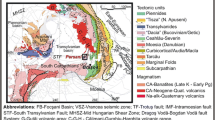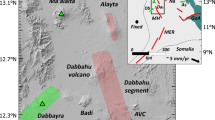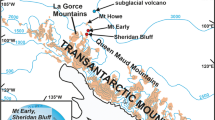Abstract
Ambrym Island has an unusually large, well-preserved basaltic caldera 13 km across. The caldera occurs in the central region of an early broad composite cone, which formed a north-south line with three smailer volcanoes. Alter the caldera was formed volcanism occurred within it and along fissure lines running nearly east-west. Two volcanic cones are active almost continuously and historic fissure cruptions have been recorded.
The caldera formed by quiet subsidence, or by subsidence accompanied by eruption of scoria lappili similar to that erupted prior and subsequent to caldera formation. The collapse was at least 600 metres and radiocarbon dating suggests it took place less than 2000 years ago.
The caldera is detined by gravity anomalies 10 to 14 milligals lower than those at its rim suggesting predominantly ash infilling. Aeromagnetic anomalies show a prominent. nearly east-west lineation, with normally magnetised bipole anomalies over the centre of the caldera and over fissure lines east of it. The source of the present volcanic activity is believed to be located along dyke fissures, with a perched magma chamber beneath the caldera.
The geophysical evidence on Ambrym, together with that of regional east trending magnetic anomalies and recent bathymetric results, suggests that the volcanic activity is localised by the intersection of an east-west fracture zone with the axis of the New Hebrides island are.
Similar content being viewed by others
References
Grant, F. S. andMartin, L., 1966,Interpretation of aeromagnetic maps by use of characteristic curves. Geophysics, Vol. 31 (1), p. 135–148.
Laudon, T. S., 1968,Land gravity surveys of the Solomon and Bismark Islands. In:The Crust and the Upper Mantle of the Pacific Area. Am. Geophys. Union Monograph12, p. 279–295.
Malahoff, A. andWoollard, G. P., 1966,Magnetic studies over the Hawaiian Islands and their geological implications. Pacific Science, Vol. 20, (3), p. 285–311.
————— and —————, 1966,Magnetic and tectonic trends over the Hawaiian Ridge. In:The Crust and the Upper Mantle of the Pacific Area. Am. Geophys. Union Monograph12, p. 241–276.
McCall, G. J. H., 1963,Classification of Calderas — Krakatoa and Glencoe types. Nature, Vol. 107, p. 1367–8.
-----, 1968,The five caldera volcanoes of the Central Rift Valley, Kenya. Proc. Geol. Soc. London, No. 1647, p. 54–58.
Williams, H., 1941,Calderas and their origin. Tech. Publ. Univ. of California, Dept. of Geol. Sci., Vol. 25, p. 239–346.
Woollard, G. P., 1951,A gravity reconnaisance of the island of Oahu. Trans. Am. Geophys. Union, Vol. 32, p. 358–368.
—————, 1959,Crustal structure from gravity and seismic measurements. J. Geophys. Res., Vol. 69, p. 1521–1544.
Yokoyama, I., 1963,Structure of caldera and gravity anomaly. Bull. Volcan., T. XXVI, p. 67–72.
Author information
Authors and Affiliations
Rights and permissions
About this article
Cite this article
McCall, G.J.H., LeMaitre, R.W., Malahoff, A. et al. The geology and geophysics of the ambrym caldera, New Hebrides. Bull Volcanol 34, 681–696 (1970). https://doi.org/10.1007/BF02596698
Received:
Issue Date:
DOI: https://doi.org/10.1007/BF02596698




